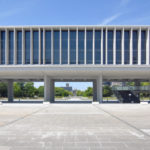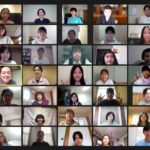Column: The Hiroshima Mayor’s Peace Declaration
1 The Peace Declaration
Since the first Peace Festival held in 1947, a Peace Declaration has been delivered by each successive mayor during the annual August 6 Peace Memorial Ceremony, with the exception of 1950 (the speech in 1951 was called Message from the Mayor). In the ceremony, a Peace Declaration addresses the peace issues being faced by Hiroshima, Japan, and the world in that year and communicates a path to Japan and the rest of the world for overcoming those issues. A complete Peace Declaration archive has been made public on the Hiroshima City website1) to enable the public to grasp the issues and historical backdrop of every year.
2 Peace Declarations of Successive Mayors
(1) Shinzo Hamai (mayor from 1947-1955)
The declarations up to 1949 emphasized renunciation of war and world peace but did not address the repudiation of nuclear weapons. Under the Allied Occupation, speaking of atomic bombings was strongly restricted by the press code. Independence was restored in 1952 with the enforcement of the Treaty of Peace , and in the following year the phrase “the scars of the crime perpetrated by that bomb” appeared; but even within Japan there was little awareness of atomic bombings and nuclear weapons, and the declaration emphasized establishing a lasting peace.
(2) Tadao Watanabe (mayor from 1955-1959)
Spurred by the Bikini Atoll incident in 1954, and amid a growing movement against atomic and hydrogen bombs, this mayor spoke of the survivors’ A-bomb diseases and the dangers of radiation for the first time (1955), and advocated banning the manufacture and use of nuclear weapons (1958).
(3) Shinzo Hamai (mayor from 1959 1967)
Nearly every year this mayor made an appeal for the banning of nuclear weapons and the total renunciation of war. In addition, he made assertions based on the international situation of the time, including an assessment of the Partial Test Ban treaty concluded by the United States, the United Kingdom, and the Soviet Union (1963), and expressing concern over the Vietnam War (1965,1966).
(4) Setsuo Yamada (mayor from 1967-1975)
For the first time, the abolition of nuclear weapons was argued for rather than their banning or abandonment (1970). Thereafter, it continued to be a part of the declaration. The themes were diversified, specified, and globalized, and included criticism of the nuclear deterrent theory (1968), writing “Hiroshima” using katakana letters (1970), pitting out the importance of the UN, environmental issues, and peace studies (1972), and criticizing nuclear power states by name (1973).
(5) Takeshi Araki (mayor from 1975-1991)
References to the UN increased, reflecting the delay in nuclear disarmament between the United States and the Soviet Union. Proposals and activities originating with Hiroshima were incorporated into the declaration, including collaboration with Nagasaki City (1975), the demand for the enactment of the Atomic Bomb Survivors’ Support Law (1980), a proposal for the establishment of an international peace research institute (1982), holding the World Conference of Mayors for peace through Inter-city Solidarity (1984), and support for A-bomb survivors living abroad (1990).
(6) Takashi Hiraoka (mayor from 1991-1999)
This mayor presented numerous proposals in the declarations that reexamined Japan’s actions, including an apology to Asia and the Pacific regarding Japan’s colonial rule and war (1991), the establishment of a nuclear-free zone in Northeast Asia (1994), looking at the stark reality of war in terms of both aggrieved and aggrieved (1995), and devising security arrangements that do not rely upon nuclear umbrella (1997).
(7) Tadatoshi Akiba (mayor from 1999-2011)
This mayor for the first time wrote using the polite colloquial “-desu/-masu” form of Japanese speech. He expressed gratitude to the A-bomb survivors and praised their contributions (1999). He proposed reconciliation among nations hostile towards one another (2000); holding Hiroshima-Nagasaki peace study courses in major universities around the world (2001); and a visit to Hiroshima by the president of the United States (2002, 2003). With the 2005 and the 2010 Nuclear non Proliferation Treaty Review Conferences in mind, he championed the conclusion of a nuclear weapons convention and the achievement of total abolition of nuclear weapons by 2020.
(8) Kazumi Matsui (mayor from 2011)
This mayor continues using the polite colloquial “-desu/-masu” form of Japanese speech. Each year he publicly asks A-bomb survivors to contribute their A-bomb experiences to be included in the first half to the Peace Declaration. In addition, after the Fukushima nuclear power station accident, he has continued to seek a swift reassessment of energy policies, as well as advocate denuclearization of North Korea and the creation of a nuclear-weapon free zone in Northeast Asia (2013).
3 The Role that should be Fulfilled by the Peace Declaration
A close look at the appeals presented in the Peace Declaration shows that they have indeed changed with the times. First, it is surprising to realize anew that during the Occupation even the use of the words “atomic bomb” was avoided and “peace” was always stressed.
In addition, an examination of the declarations leaves an impression that the majority of ideas and proposals that are established today were first addressed in the Peace Declaration at a surprisingly late date. For example, the appeal for total elimination of nuclear weapons appeared 25 years after the atomic bombing. Collaboration with Nagasaki City occurred 30 years after the atomic bombing, and support for overseas A-bomb survivors was mentioned 45 years later.
Furthermore, Takashi Hiraoka, the first mayor to start out as a journalist, was the first to touch on the violence brought by Japan’s was, rather than simply mention the damage of the atomic bomb exposure. He presented proposal that went beyond the framework of Peace Declarations up to that point, including casting away the necessity of searching for security arrangements that relied on nuclear umbrellas.
After entering the 21st century and as the international situation has diversified, the content incorporated into the Peace Declaration has also become more diversified. More than before, Tadatoshi Akiba has prioritized communicating overseas. He read aloud an English-language version of the Peace Declaration for the first time and released a video of it on the Internet. Moreover, as it becomes more difficult to pass on the A-bomb survivor to serve as mayor, has continued to solicit accounts of the experiences of survivors and was the first to include them in the Peace Declaration.
Even if the times change, the importance of the role that the Peace Declaration is expected to play has, rather than remain constant, grown even more important. The mayor of Hiroshima City will continue to be counted on to surpass factions and positions, and bring the “voice” of Hiroshima to the world through the Peace Declaration.
(Kazumi Mizumoto)
Note
1. Hiroshima City website
http://www.city.hiroshima.lg.jp/www/genre/0000000000000/1111135185460/
Tags associated with this article





